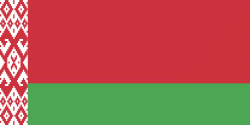Kreva
Kreva (Крэва, ; Krėva or Krẽvas; Krewo; Крéво) is a township in the Smarhon District of Grodno Region, Belarus. The first mention dates to the 13th century. The toponym is derived from the name of the Krivichs tribe.
The Kreva Castle, constructed of brick, was built by the Grand Duke of Lithuania Gediminas in ethnically Lithuanian lands. After his death in 1341, Kreva became the patrimony of his son and successor, Algirdas. In 1382, the Grand Duke Kęstutis was imprisoned in Kreva during the Lithuanian Civil War and subsequently murdered on the order by his nephew Jogaila.
The ruins of the castle were severely damaged during World War I, as they were near the front lines. They remain extant to the present day.
In 1385, the Union of Krewo (Act of Kreva) was signed in Kreva.
In 1387, following the Christianization of Lithuania, the Grand Duke Jogaila established the first Catholic parish in the Lithuanian pagan lands and built a church which is now known as the Church of St. Mary.
Before World War II, 500 Jews lived in the village. After the German occupation of the town they are kept imprisoned in a ghetto and used as slave labourers in harsh conditions. They are deported in other ghettos in Vilnius and Ashmyany in 1942.
The Kreva Castle, constructed of brick, was built by the Grand Duke of Lithuania Gediminas in ethnically Lithuanian lands. After his death in 1341, Kreva became the patrimony of his son and successor, Algirdas. In 1382, the Grand Duke Kęstutis was imprisoned in Kreva during the Lithuanian Civil War and subsequently murdered on the order by his nephew Jogaila.
The ruins of the castle were severely damaged during World War I, as they were near the front lines. They remain extant to the present day.
In 1385, the Union of Krewo (Act of Kreva) was signed in Kreva.
In 1387, following the Christianization of Lithuania, the Grand Duke Jogaila established the first Catholic parish in the Lithuanian pagan lands and built a church which is now known as the Church of St. Mary.
Before World War II, 500 Jews lived in the village. After the German occupation of the town they are kept imprisoned in a ghetto and used as slave labourers in harsh conditions. They are deported in other ghettos in Vilnius and Ashmyany in 1942.
Map - Kreva
Map
Country - Belarus
 |
 |
| Flag of Belarus | |
Until the 20th century, different states at various times controlled the lands of modern-day Belarus, including Kievan Rus', the Principality of Polotsk, the Grand Duchy of Lithuania, the Polish–Lithuanian Commonwealth, and the Russian Empire. In the aftermath of the Russian Revolution in 1917, different states arose competing for legitimacy amid the Civil War, ultimately ending in the rise of the Byelorussian SSR, which became a founding constituent republic of the Soviet Union in 1922. After the Polish-Soviet War, Belarus lost almost half of its territory to Poland. Much of the borders of Belarus took their modern shape in 1939, when some lands of the Second Polish Republic were reintegrated into it after the Soviet invasion of Poland, and were finalized after World War II. During World War II, military operations devastated Belarus, which lost about a quarter of its population and half of its economic resources. The republic was redeveloped in the post-war years. In 1945, the Byelorussian SSR became a founding member of the United Nations, along with the Soviet Union.
Currency / Language
| ISO | Currency | Symbol | Significant figures |
|---|---|---|---|
| BYN | Belarusian ruble | Br | 2 |
| ISO | Language |
|---|---|
| BE | Belarusian language |
| RU | Russian language |















